Adherence has been defined as: “the extent to which a person’s behaviour… corresponds with agreed recommendations from a healthcare provider” (1)
Adherence with treatment is an important factor which can influence the outcome of that treatment (2). It has been suggested that adherent patients are likely to have better treatment outcomes than non-adherent patients (3).
For practitioners of manual therapy, rehabilitation and exercise therapy prescription is part of a multimodal management strategy utilised to improve clinical outcomes. It has been shown that patients who are more committed to their therapy after hip resurfacing returned to higher levels of functionality and were more satisfied following their surgery.(4) Conversely, it has been suggested that non-adherence with treatment could be as high as 70% (5).
Martin et al (6) have stated: “Patient non-adherence can be a pervasive threat to health and wellbeing and carry an appreciable economic burden as well. In some disease conditions, more than 40% of patients sustain significant risks by misunderstanding, forgetting, or ignoring healthcare advice.”
While no single intervention strategy can improve the adherence of all patients, home exercise programs – such as the ones you can create on Erepsonline – have been shown to increase patient adherence.(4, 7-9)
Visit the Help & Support page to watch short video clips of the various features of Erepsonline.
References:
- WHO . World Health Organisation; Geneva: 2003. Adherence to Long Term Therapies – Evidence for Action.
- Hayden J.A., van Tulder M.W., Tomlinson G. Systematic review: strategies for using exercise therapy to improve outcomes in chronic low back pain. Annals of Internal Medicine. 2005;142(9):776–785.
- Vermeire E., Hearnshaw H., Van Royen P., Denekens J. Patient adherence to treatment: three decades of research. A comprehensive review. Journal of Clinical Pharmacy and Therapeutics. 2001;26(5):331–342.
- Marker DR, Seyler TM, Bhave A, Zywiel MG, Mont MA. Does commitment to rehabilitation influence clinical outcome of total hip resurfacing arthroplasty? Journal of Orthopaedic Surgery and Research 2010, 5:20
- Vasey L. DNAs and DNCTs – why do patients fail to begin or complete a course of physiotherapy treatment? Physiotherapy. 1990:76575–76578.
- Martin LR, Wiliams SL, HAskars KB, DiMatteo MR. The challenge of patient adherence. Ther Clin Risk Manag. 2005 Sep; 1(3): 189–199.
- Coulter CL, Scarvell JM, Neeman TM, Smith PN. Physiotherapist-directed rehabilitation exercises in the outpatient or home setting improve strength, gait speed and cadence after elective total hip replacement: a systematic review. J Physio. 2013;59(4):219-26
- Latham NK, Harris BA, Bean JF, Heeren T, Goodyear C, Zawack S, Heislein DM, Mustafa J, Pardasaney P, Giorgetti M, Holt N, Lori Goehring L, Jette AM. Effect of a Home-Based Exercise Program on Functional Recovery Following Rehabilitation After Hip Fracture: A Randomized Clinical Trial. JAMA. 2014;311(7):700-708.
- Jan MH, Hung JY, Lin JC, Wang SF, Liu TK, Tang PF. Effects of a home program on strength, walking speed, and function after total hip replacement. Arch Phys Med Rehabil. 2004 Dec;85(12):1943-51.
